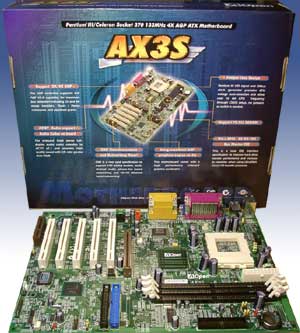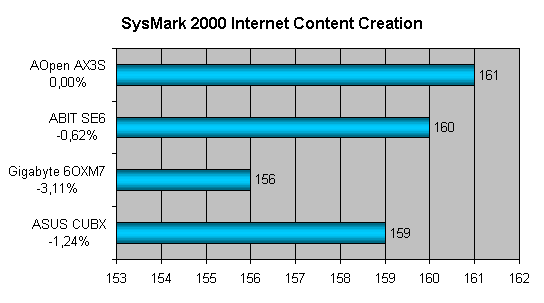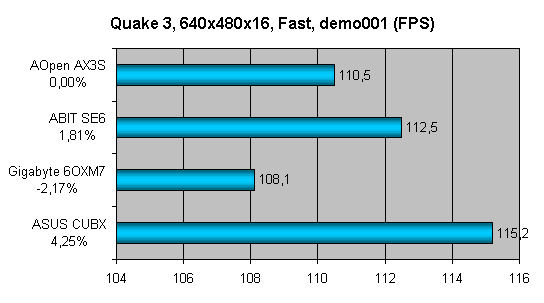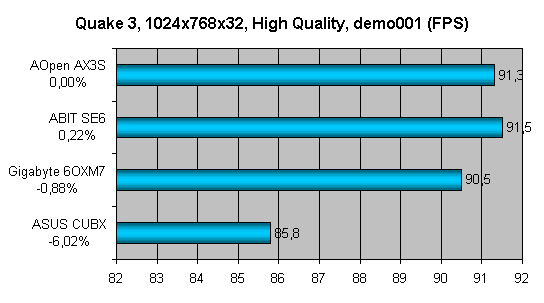 |
||
|
||
| ||
The AOpen company is a member of ACER Group, that disposes of $US 7 billion, has a 22-year experience and more than 700 patents for PC technologies. The name means "ALWAYS OPEN". The conception of openness is realized in its "Open Architecture" products, "Open Mind" engineering developments and "Open Business" communication with distributors and end-users. The company's production includes computer platforms, motherboards, CD-ROM/CD-RW/DVD-drives, displays, multimedia etc. "Open Architecture" means maximum compatibility. "Open Mind" means usage of the latest technologies. "Open Business" means long lasting good relations with its partners and twenty-four-hour technical support for users. The chief business trick consists in the production of the small lots of exclusive boards. For example, the company has started production of the boards on the black textolite with platinum evaporation on a chipset heatsink; these boards have an engraved model, series number and its own name ("Millenium Edition", "Black Beauty" etc). Another exclusive representative is a board with the index "Pro" (stands after model's name); they have a golden heatsink. The "Pro" indicates that this product has some advantage in comparison with its usual brother. For example, AX3S based on i815E chipset and its "Pro"-version differ in Die-Hard BIOS (2 BIOS chips instead of one) and capacitors for 2200 uF instead of 1500 uF.  Specification
 Last years we could see a new tendency in development of packages: beside a usual box the company has introduced a box with a figure cut-out and transparent plastic covering the cut-out, so you may see what is inside. Moreover, the company went further: they developed a special plastic suitcase for the whole complete set. The complete set is also worth to mention: 80-thread UltraDMA/100 cable, 40-thread usual IDE cable, FDD cable and the second COM port connector, 2 CDs (the first one contains Norton Antivirus 2000, the second contains a set of drivers and a documentation for all motherboards from AOpen in PDF-format). The manual, however, doesn't offer much information. It probably means that the board wouldn't cause you any problems. So, we are going to check it. The boardThe AX3S board is implemented in Standard ATX format, its size is 30,5X22 sm - it's a typical size allowing to locate all necessary components without additional chips such as IDE or SCSI controller. It will perfectly suit any good ATX-case. The fact, that the board belongs to ATX form factor, you can feel from the name: The first letter "A" means ATX, the figure "3" - Socket370, and "S" - i815 chipset (Solano). In pulse converters the potential is given by 11 LowESR capacitors of 1500 uF. LowESR means Low Equivalent Series Resistor. For stable work of processors at high frequency the voltage jumps on the supply filter's output mustn't exceed 280 mV at the supply voltage equal 2V. For 1500 uF capacitors of this board this figure is equal to 143 mV. After installation of a new BIOS version 1.08R of September 5, the board stability increased, and during 24-hour crash-test under Windows NT 4 (with Service Pack 6 installed) the board showed excellent results - only 4 failures. The Aopen company states that its Pro-version shows even better results. Unfortunately, we couldn't compare the results, since we couldn't fetch this board. As for a cooler installation, on the first look the board seems to have enough space for it. But in practice, we had difficulty in installing even a usual Intel cooler, not to mention Golden Orb. Another peculiarity is that all slots are shifted to the left side; so, AGP slot isn't located tight to the ports anymore. In result there are only 5 PCI slots, and CNR slot. With this layout an installed AGP-videocard doesn't prevent any manipulation with memory clips. When developing an electric design of the boards, AOpen used the Frequency Isolation Wall technology. The idea of this technology is the following: a board is divided in several parts with similar frequency values, and then these parts are isolated not to induce an emf. It seems that due to this technology CD-IN jack is located not very convenient; AGP-videocards cover it. Besides, IDE jacks, which are parallel to PCI-slots, prevent easy installation of a full-sized PCI-card into the first PCI-slot located next to AGP. A power supply jack hasn't a good location as well. The cable doesn't leave enough space for a cooler. The board has 3DIMM slots, though this is more than enough for i815 northbridge (you won't be able to set more than 512 MBytes memory). DieHARD BIOS is not included in AX3S. Although there is special space for the second chip (see the photo above). As for Award Medallion 6.0 based BIOS, we haven't noticed anything new. Although, there are all necessary things (thin configuration of memory timings and IRQ distribution). Then, a user can save its own settings in EEPROM. The part of EEPROM is implemented independently from BIOS and can save the settings as long as you want. The sound is realized within an integrated AC'97 codec from Analog Devices - AD1885. It has SoundMax drivers, allowing to make the maximum use of it. Besides, there are some novations. For example, GPIO (General Purpose In/Out) connector. The board has 2 red LEDs (the first lights up while power supply on DIMM slots, the second twinkles during POST process and lights in case of the system doesn't pass). There is a special connector for PC-Doctor Debug. This device is designed in a form of a box, which is installed in 5.25 inch module. The front panel has 8 indicators. Unfortunately, it's not included in the complete set.  Besides, there included hardware monitoring, holes for installation in the case etc etc. OverclockingThe AX3S board includes 26 available frequency values of FSB: 66.6, 66.8, 68.3, 75.3, 78, 80, 95, 100, 100.2, 105, 110, 114, 117, 127, 129, 133.3, 133.6, 138, 140, 144, 146.4, 150, 157.3, 160 and 166 MHz. The most popular overclocking is a FSB frequency plus 0,2-0,3 MHz (66.6 -> 66.8, 100 -> 100.2, 133.3 -> 133.6), what i.e. with a multiplier 7 will result in 2 MHz frequency increase. One of the merits is compulsory setting of the FSB/PCI ratio by jumpers, for example, for those whose Celeron doesn't work at 100+ MHz of the bus and at the low frequency PCI gets FSB/2. The core voltage can be adjusted in the range of 1.3 V to 2.1 V with a 0.05 V step, and in the range between 2.1 V and 3.5 V with a 0.1V step. Notice, that it doesn't depend on the nominal processor voltage. It means, that on the 1.65 V processor you can set both 1.7 and 3,5 V. You can easily burn your processor! However, we achieved quite admirable results: at 1.7 V the test CopperMine 700 MHz reached 133.6 FSB, that is 935 MHz, and at 1.75 V it reached 138 x 7 = 966 MHz. Now its record is 987 MHZ on the EpoX-BX7+ board. Well, if you are not afraid to increase the voltage, then your processor might be able to leave aside the barrier of +33 MHz to its regular FSB. PerformanceThe testbed:
Software:
The change of the drivers of the videocard for the Detonator v6.26 did not allow to use the results of the previous tests and called forth the difference from the results, which had been showed by the i815 based boards. The BIOS optimization of the i815 based boards made a contribution to the game performance increase at high resolutions.    Well, the showed results look quite attractable both with i815, and BX (which, unfortunately, lacks for AGP 4x). ConclusionHalf a year was quite enough for the manufacturers of i815 based boards to include a new BIOS version of, at least, an end of August. A new BIOS version (in AX3S) improved the board much. Although you'd better get the AX3S Pro, it will satisfy you completely, if you are not an overclocker. Highs:
Lows:
Write a comment below. No registration needed!
|
Platform · Video · Multimedia · Mobile · Other || About us & Privacy policy · Twitter · Facebook Copyright © Byrds Research & Publishing, Ltd., 1997–2011. All rights reserved. |